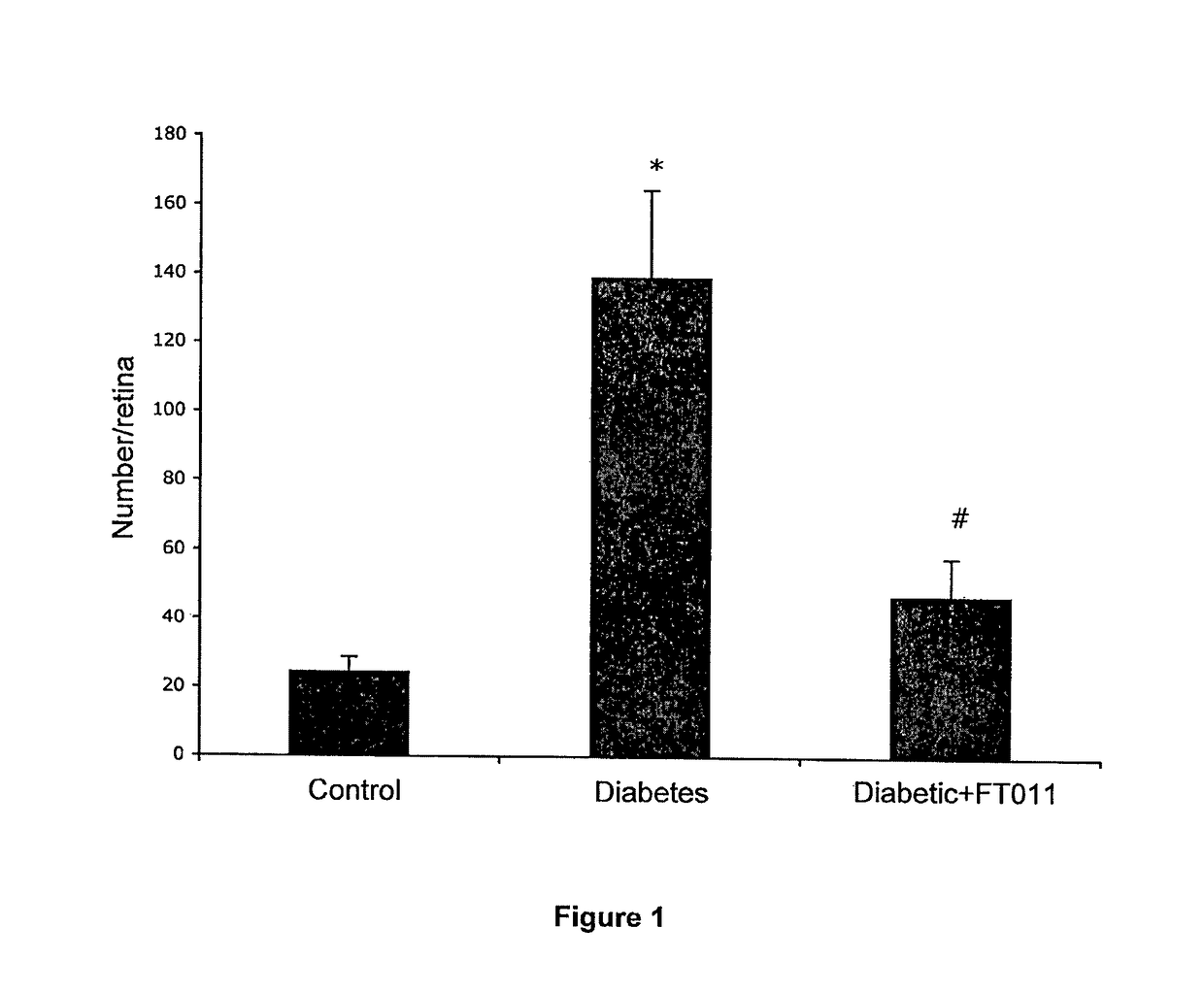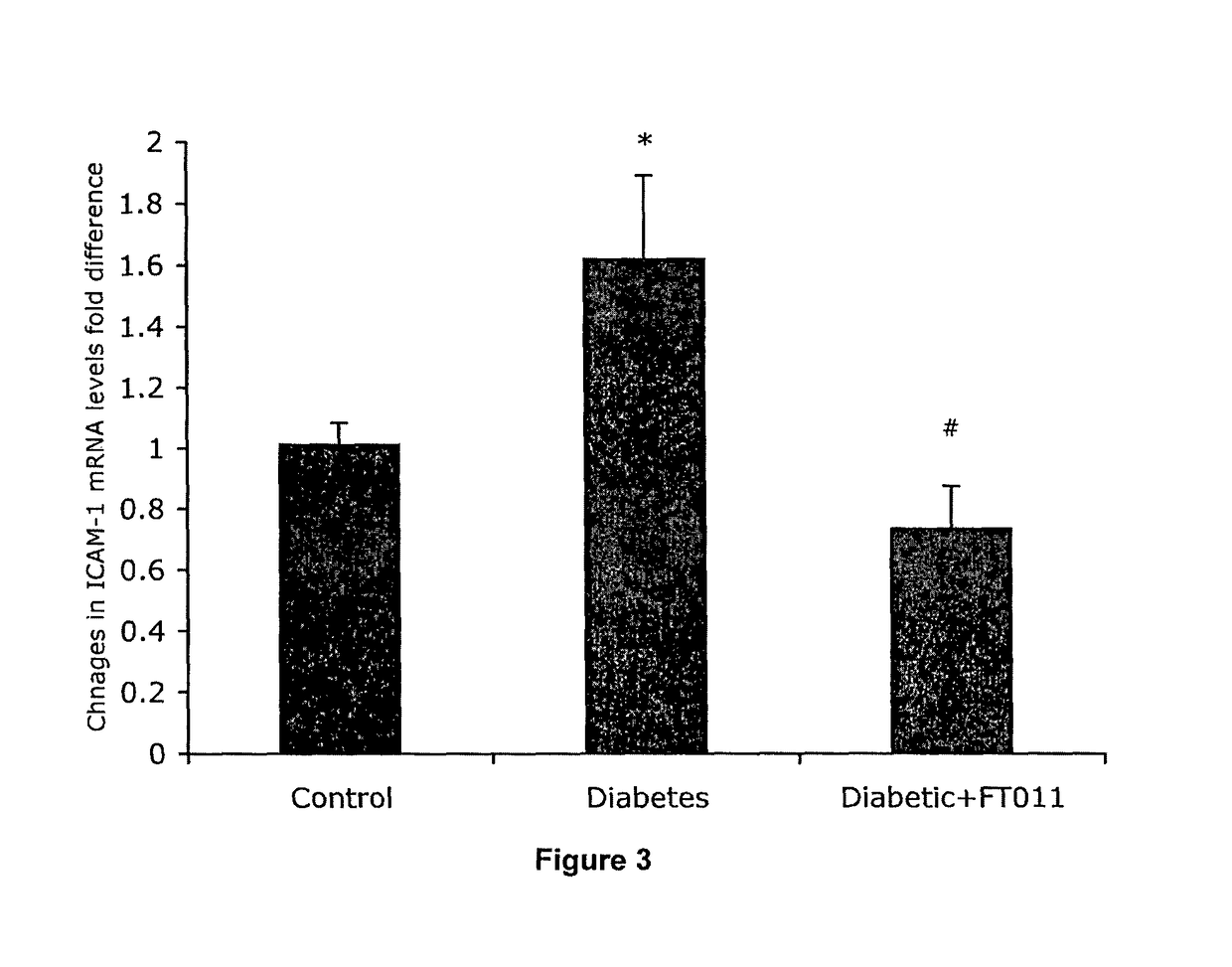Methods of treating eye diseases associated with inflammation and vascular proliferation
a technology of vascular proliferation and eye diseases, applied in the direction of antibacterial agents, drug compositions, antiparasitic agents, etc., can solve the problems of pathological angiogenesis and scarring, damage to healthy retinas, and increased production of angiogenic growth factors, so as to prevent eye disease, improve eye disease symptoms, and inhibit the progression of eye diseas
- Summary
- Abstract
- Description
- Claims
- Application Information
AI Technical Summary
Benefits of technology
Problems solved by technology
Method used
Image
Examples
example 1
Test Compound (FT011)
(E)-2-[[3-(3-Methoxy-4-propargyloxy)phenyl)-1-oxo-2-propenyl]amino]benzoic acid (FT011) has the structure
[0311]
Diabetic Retinopathy Rats
[0312]Ninety, six-week old female, heterozygous (mRen-2) 27 rats (St. Vincent's Hospital Animal House, Melbourne, Australia) were assigned to receive either 55 mg / kg of streptozotocin (STZ) (Sigma, St. Louis, USA) diluted in 0.1 M citrate buffer, pH 4.5 or citrate buffer alone (non-diabetic control) by tail vein injection following an overnight fast. In short term study, rats were randomly assigned to receive (n=10 / group) treatment with either FT011 (100 mg / kg bid gavage) or vehicle for 8 weeks. Non-diabetic animals (n=10) served as controls. In the long term study, at 16 weeks of STZ diabetes rats were randomly assigned to either treatment (n=15 / group) with, FT011 (50 mg / kg / day BID), FT011 (100 mg / kg BID) or no treatment for a further 16 weeks. Non-diabetic animals (n=15) served as controls. Each week, rats were weighed and the...
example 2
Test Compound (FT061)
(E)-2-[[3,4-Bis(difluoromethoxy)phenyl)-1-oxo-2-propenyl]amino]benzoic acid (FT061) has the structure:
[0326]
Diabetic Retinopathy Rats
[0327]Sixty, six-week old female, heterozygous (mRen-2) 27 rats (St. Vincent's Hospital Animal House, Melbourne, Australia) were assigned to receive either 55 mg / kg of streptozotocin (STZ) (Sigma, St. Louis, USA) diluted in 0.1 M citrate buffer, pH 4.5 or citrate buffer alone (non-diabetic control) by tail vein injection following an overnight fast. Rats were randomly assigned to receive (n=15 / group) treatment with either FT061 (100 mg / kg / day gavage) or vehicle for 8 weeks. Non-diabetic animals (n=15) served as controls. Each week, rats were weighed and their blood glucose levels were measured (Accu-check Advantage II Blood Glucose Monitor, Roche Diagnostics, USA) and only STZ-treated animals with blood glucose >15 mmol / L were considered diabetic. Every 4 weeks, SBP was determined in preheated conscious rats via tail-cuff plethysmo...
PUM
| Property | Measurement | Unit |
|---|---|---|
| pH | aaaaa | aaaaa |
| pH | aaaaa | aaaaa |
| structures | aaaaa | aaaaa |
Abstract
Description
Claims
Application Information
 Login to View More
Login to View More - R&D
- Intellectual Property
- Life Sciences
- Materials
- Tech Scout
- Unparalleled Data Quality
- Higher Quality Content
- 60% Fewer Hallucinations
Browse by: Latest US Patents, China's latest patents, Technical Efficacy Thesaurus, Application Domain, Technology Topic, Popular Technical Reports.
© 2025 PatSnap. All rights reserved.Legal|Privacy policy|Modern Slavery Act Transparency Statement|Sitemap|About US| Contact US: help@patsnap.com



